Carbon Sequestration in the Urban Areas of Seoul with Climate Change: Implication for Open Innovation in Environmental Industry
Abstract
:1. Introduction
2. Materials and Methods
2.1. Study Site
2.2. Dynamic Global Vegetation Model (DGVM)
2.3. Data Handling
3. Results and Discussion
3.1. Net Primary Productivity Change by Potential Climate Change
3.2. Soil Carbon Storage Change by Potential Climate Change
3.3. Impact of Human Interference on Temperate Forest Carbon Pool
Author Contributions
Funding
Conflicts of Interest
References
- Clark, J.S.; Vose, J.M.; Luce, C.H. Forest drought as an emerging research priority. Glob. Chang. Biol. 2016, 22. [Google Scholar] [CrossRef] [PubMed]
- Intergovernmental Panel on Climate Change. IPCC Fourth Assessment Report: Climate Change (AR4): Synthesis Report. 2007. Available online: http://www.ipcc.ch/pdf/assessment-report/ar4/syr/ar4_syr.pdf (accessed on 10 January 2011).
- Thomas, C.D.; Cameron, A.; Green, R.E.; Bakkenes, M.; Beaumont, L.J.; Collingham, Y.C.; Erasmus, B.F.N.; Siqueira, M.F.; Grainger, A.; Hannah, L.; et al. Extinction risk from climate change. Nature 2004, 427, 145–148. [Google Scholar] [CrossRef] [PubMed] [Green Version]
- Carpenter, K.E.; Abrar, M.; Aeby, G.; Aronson, R.B. One-third of reef-building corals face elevated extinction risk from climate change and local impacts. Science 2008, 321, 560–563. [Google Scholar] [CrossRef] [PubMed]
- Pancholi, S.; Yigitcanlar, T.; Guaralda, M. Public space design of knowledge and innovation spaces: Learnings from Kelvin grove Urban Village, Brisbane. J. Open Innov. Technol. Mark. Complex. 2015, 1, 1–17. [Google Scholar] [CrossRef] [Green Version]
- Lara, A.; Costa, E.; Furlani, T.; Yigitcanlar, T. Smartness that matters: Comprehensive and human-centred characterisation of smart cities. J. Open Innov. Technol. Mark. Complex. 2016, 2, 1–13. [Google Scholar] [CrossRef]
- Forestry Statistical Yearbook. 2004–2010. Available online: http://www.forest.go.kr/foahome/user.tdf?a=common.HtmlApp&c=1001&page=/html/kor/information/stat/stat_030_010.html&mc=WWW_INFORMATION_STAT_040 (accessed on 10 January 2011). (In Korean).
- Nijkamp, P.; Pepping, G. A meta-analytical evaluation of sustainable city initiatives. Urban Stud. 1998, 35, 1481–1500. [Google Scholar] [CrossRef]
- Kim, J.; Kang, M.S.; Kang, S.K.; Kang, H.S.; Ku, J.W.; Kim, R.H. CarboKorea: Development of Carbon Cycle Monitoring and Assessment Technology by Integrating KoFlux Footprint, MODIS/IKONOS Satellite Image and Ecohydrology Modeling, Korea Ministry of Environment; Ministry of Environment: Seoul, Korea, 2007.
- Lim, H.J.; Lee, Y.H.; Kwon, H. Evaluation of Community Land Model version 3.5-Dynamic Global Vegetaion Model over Deciduous Forest in Gwangneung, Korea. Korean J. Agric. For. Meteorol. 2010, 12, 95–106. [Google Scholar] [CrossRef]
- Parton, W.J.; Schimel, D.S.; Ojima, D.S.; Cole, C.V. A general study model for soil organic matter dynamics, sensitivity to litter chemistry, texture, and management. In Quantitative Modeling of Soil Forming Processes; Special Publication 39; Soil Science Society of America (SSSA): Madison, WI, USA, 1994; pp. 147–167. [Google Scholar]
- Neilson, R.P. A model for predicting continental scale vegetation distribution and water balance. Ecol. Appl. 1995, 5, 362–385. [Google Scholar] [CrossRef]
- Lee, M.; Lee, W.K.; Song, C.C.; Lee, J.H.; Choi, H.A.; Kim, T.M. Spatio-temporal change prediction and variability of temperature and precipitation. Korea J. GIS Assoc. 2007, 15, 267–278. [Google Scholar]
- Park, N.W.; Jang, D.H. Mapping of temperature and rainfall using DEM and multivariate kriging. Korean Geogr. Soc. 2008, 43, 1002–1015. [Google Scholar]
- Davidson, A.E.; Janssens, I.A. Temperature sensitivity of soil carbon decomposition and feedbacks to climate change. Nature 2006, 440, 165–173. [Google Scholar] [CrossRef] [PubMed] [Green Version]
- Trumbore, S.E.; Chadwick, O.A.; Amundson, R. Rapid exchange between soil carbon and atmospheric carbon dioxide driven by Temperature Change. Science 1996, 272, 393–396. [Google Scholar] [CrossRef]
- Melillo, M.J.; Steudler, P.A.; Aber, J.D.; Newkrik, K.; Lux, H.; Bowles, F.P.; Catricala, C.; Magill, A.; Ahrens, T.; Morrisseau, S. Soil warming and carbon-cycle feedbacks to the climate system. Science 2002, 298, 2173–2176. [Google Scholar] [CrossRef] [PubMed]
- Neff, C.J.; Hooper, D.U. Vegetation and climate controls on potential CO2, DOC and DON production in northern latitude soils. Glob. Chang. Biol. 2002, 8, 872–884. [Google Scholar] [CrossRef]
- Peng, C.; Zhou, X.; Zhou, S.; Wang, X.; Zhu, B. Quantifying the response of forest carbon balance to future climate change in Northeastern China: Model validation and prediction. Glob. Plan. Chang. 2009, 66, 179–184. [Google Scholar] [CrossRef]
- Pan, Z.; Andrade, D.; Segal, M.; Wimberley, J.; McKinney, N.; Takle, E. Uncertainty in future soil carbon trends at a central U.S. site under an ensemble of GCM scenario climates. Ecol. Model. 2010, 221, 876–881. [Google Scholar] [CrossRef]
- Lal, R. Forest soils and carbon sequestration. For. Ecol. Manag. 2005, 220, 242–258. [Google Scholar] [CrossRef]
- Yang, S.D.; Sheng, J.; Adamowski, Y.; Gong, J.; Cao, J. Effect of Land Use Change on Soil Carbon Storage over the Last 40 Years in the Shi Yang River Basin, China. Land 2018, 7. [Google Scholar] [CrossRef]
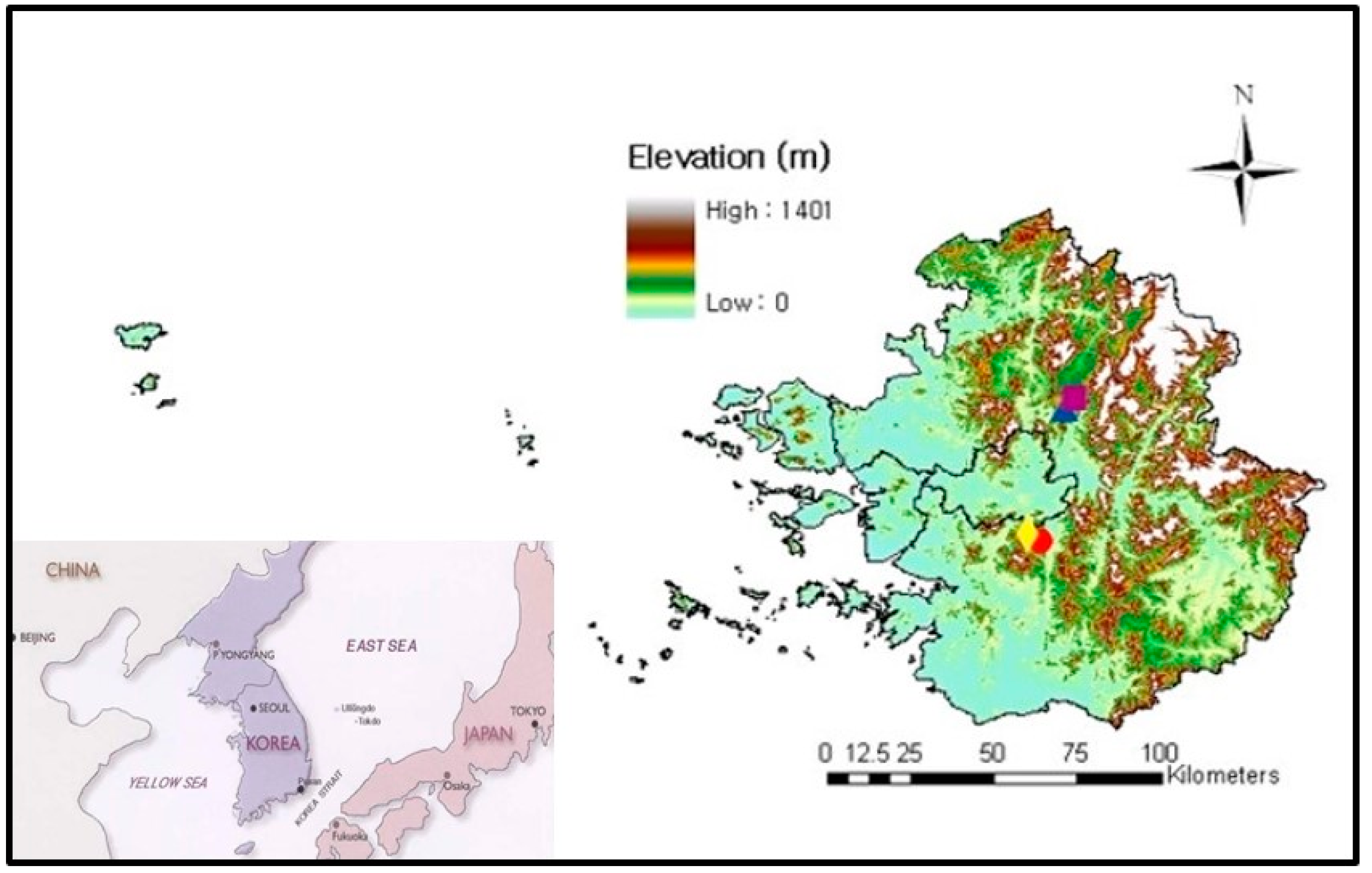
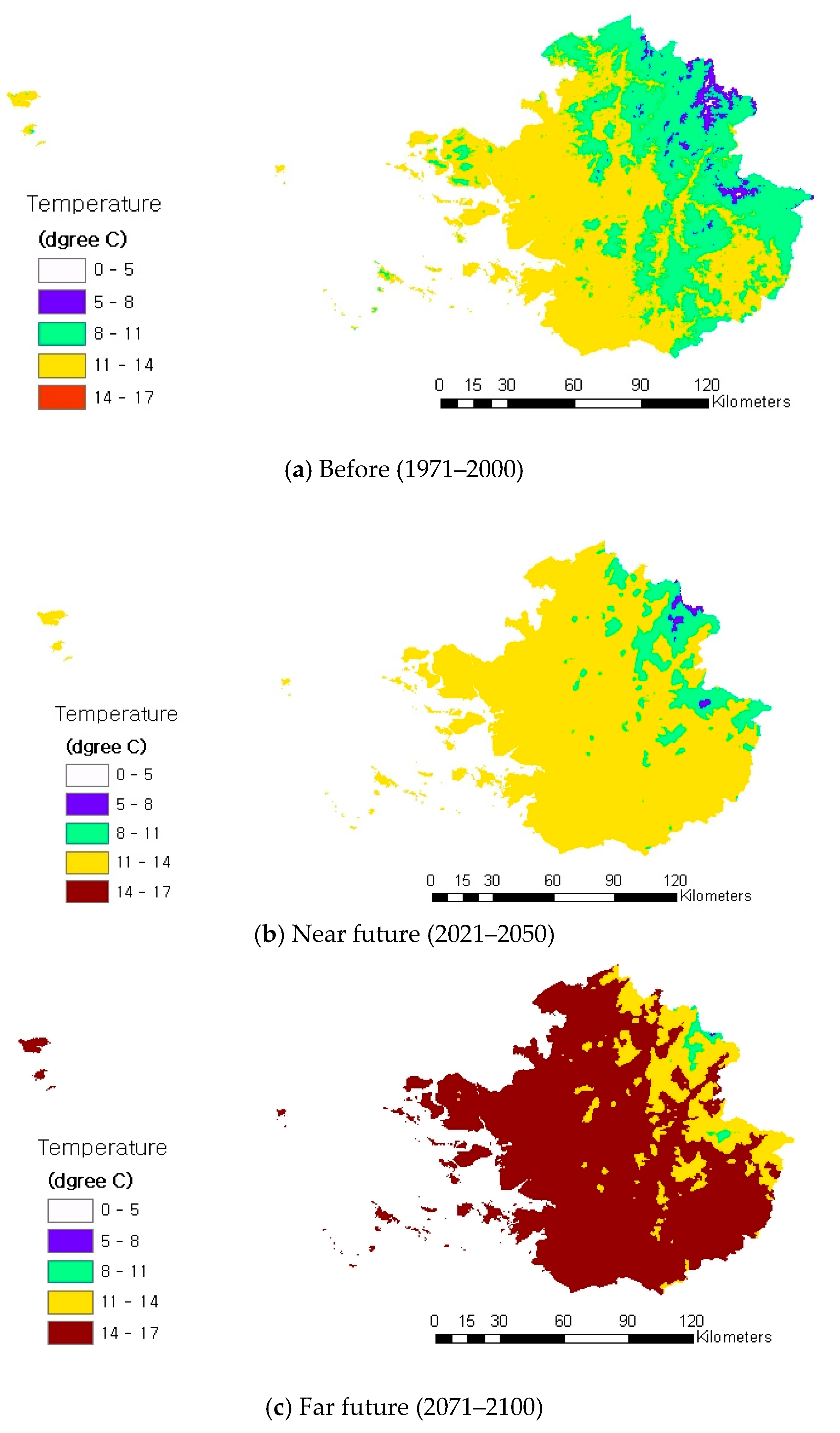
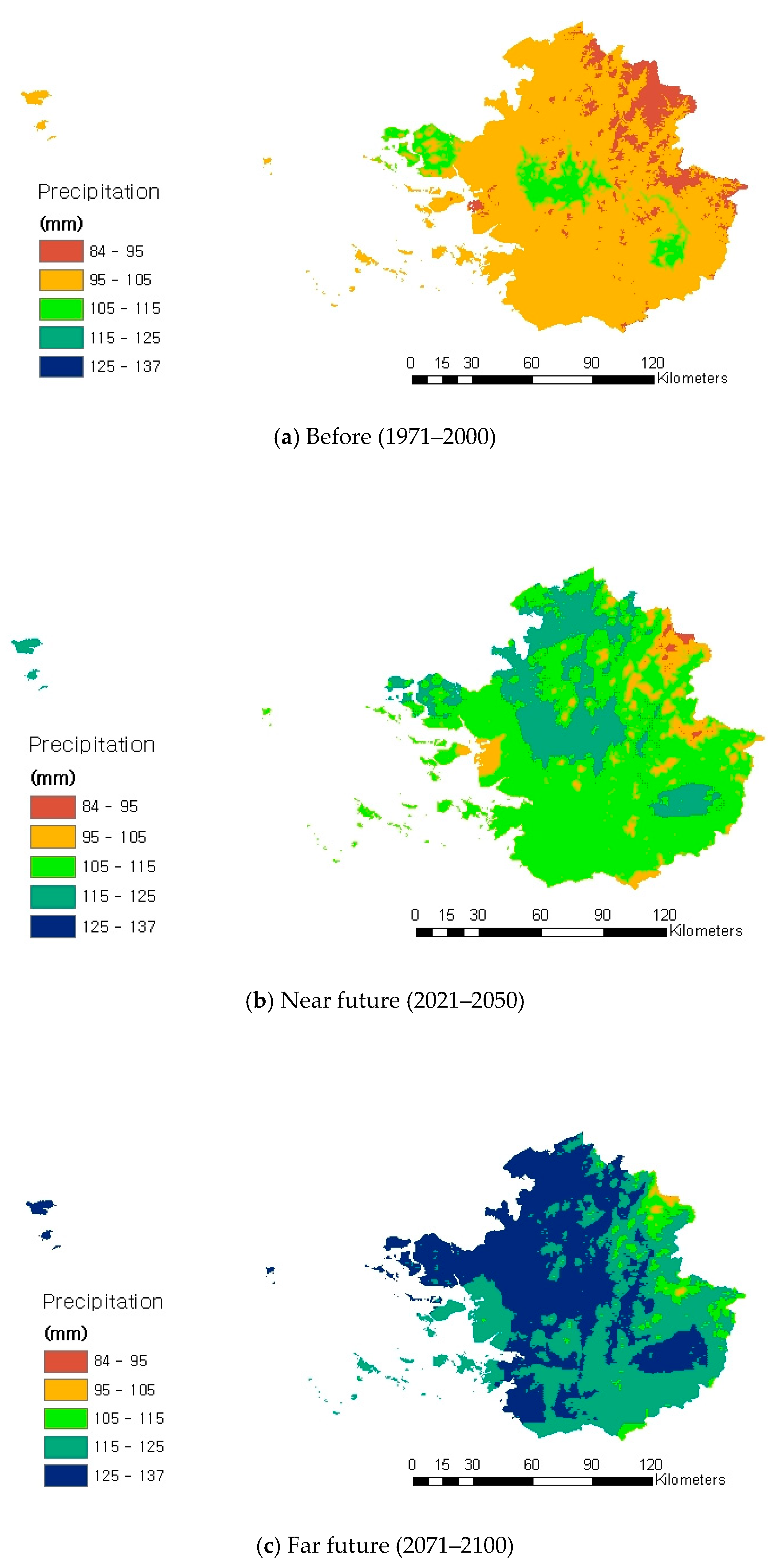
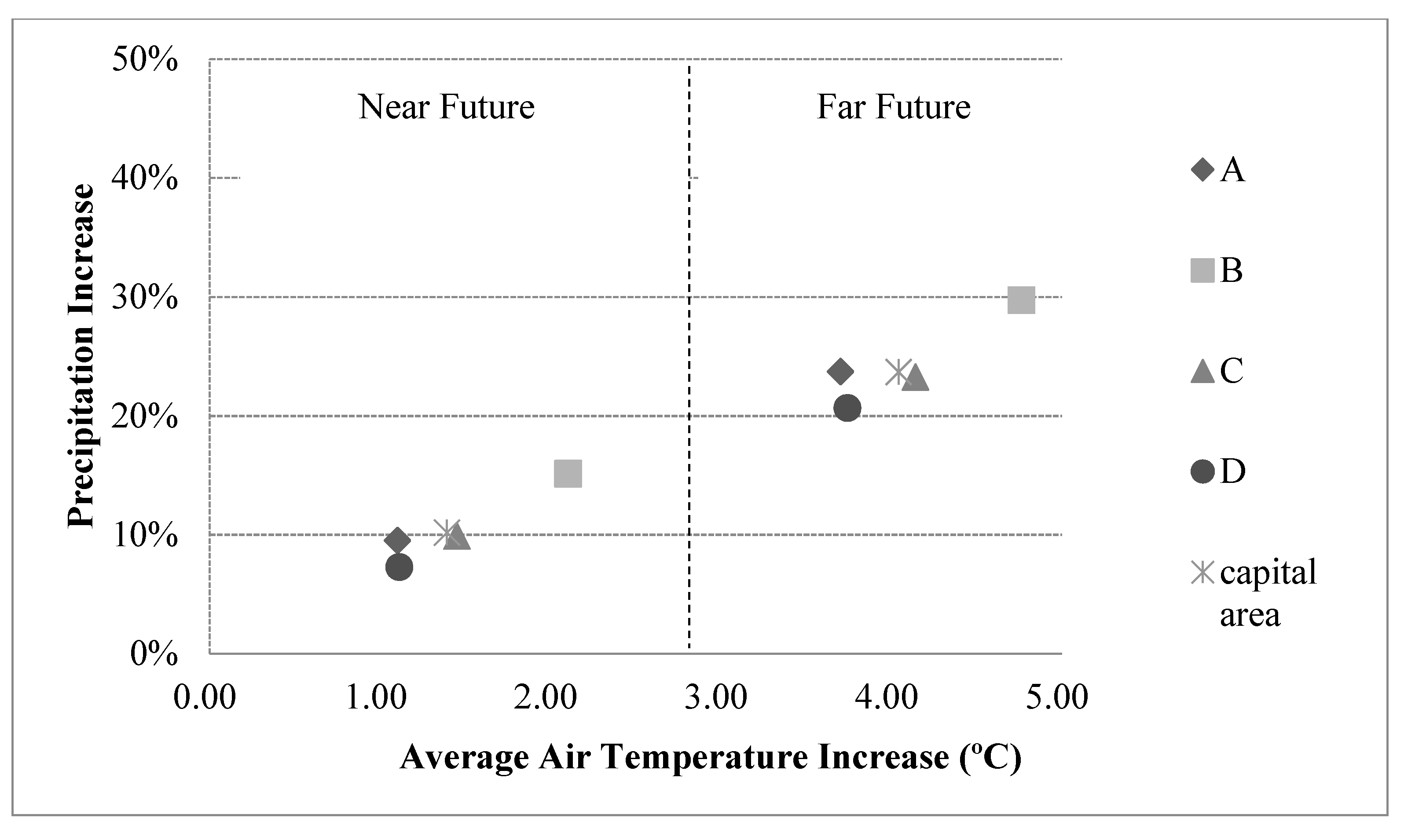

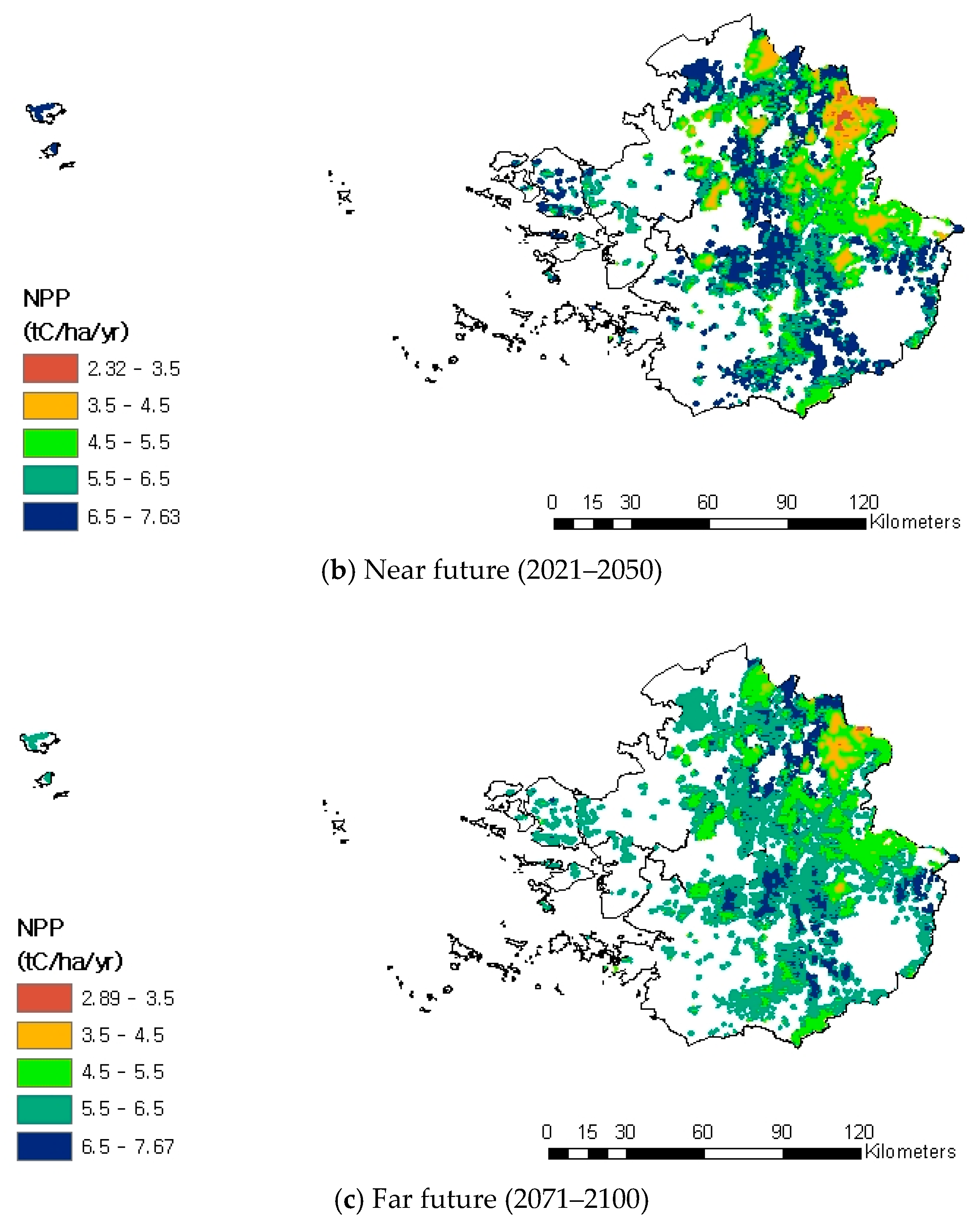
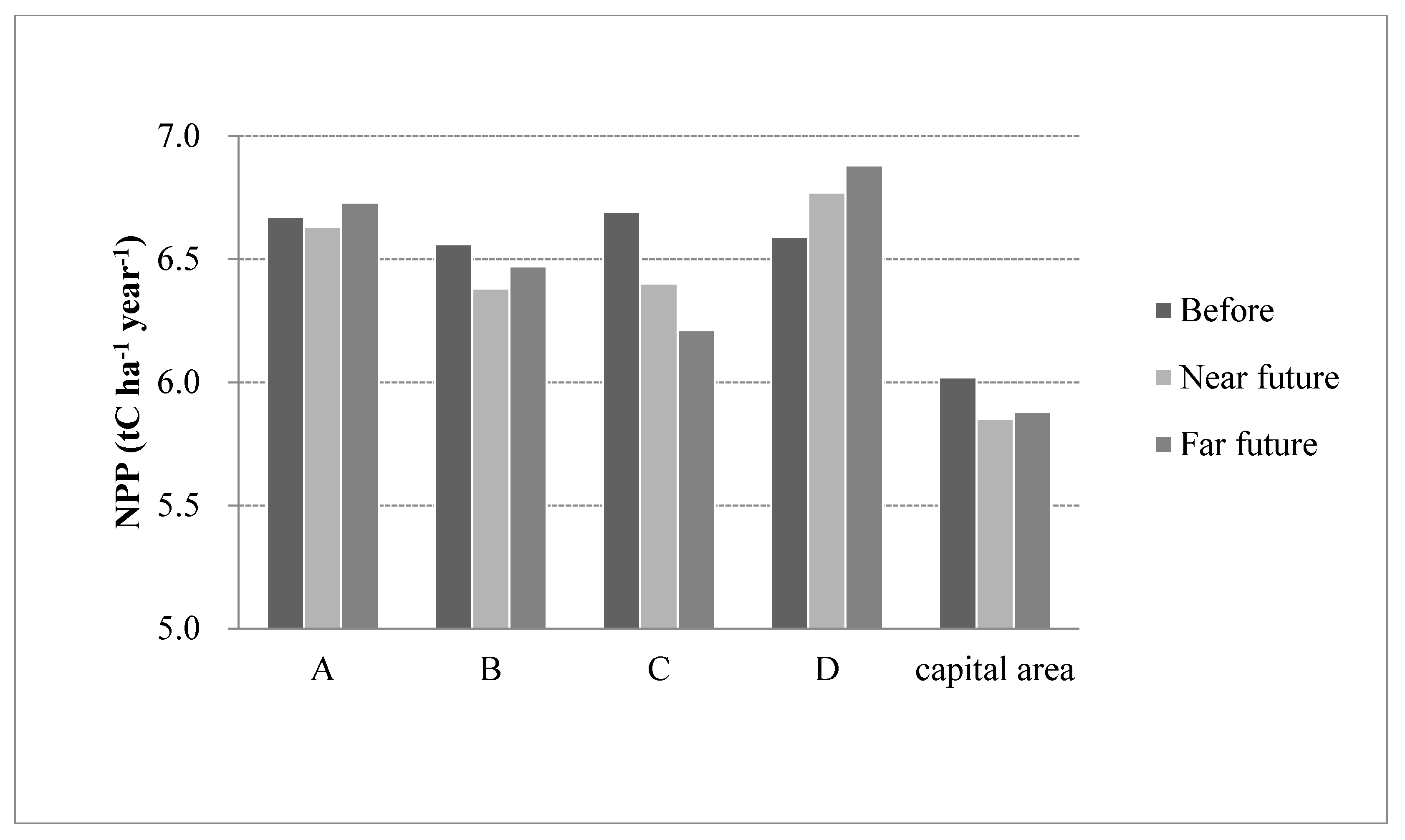
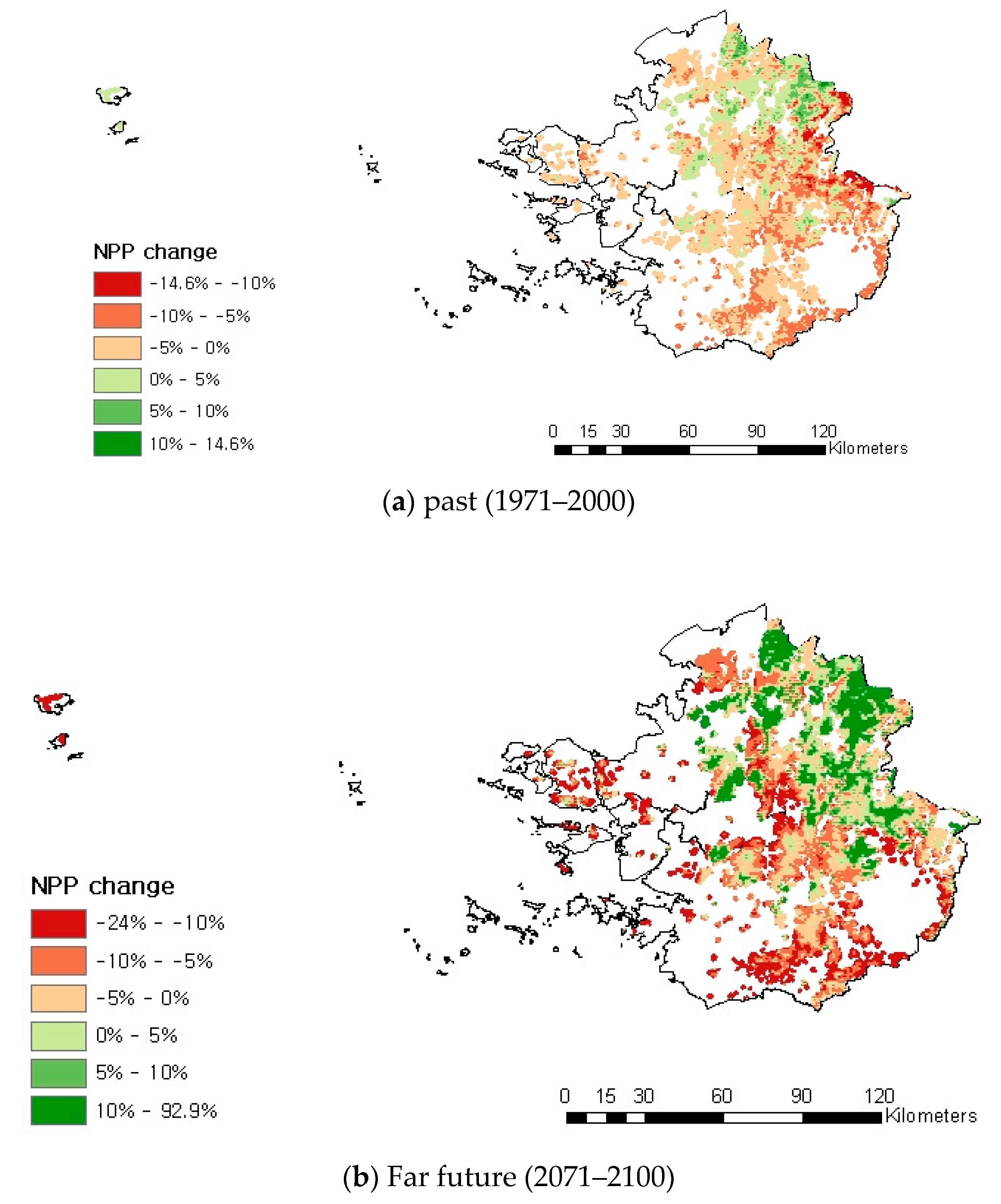
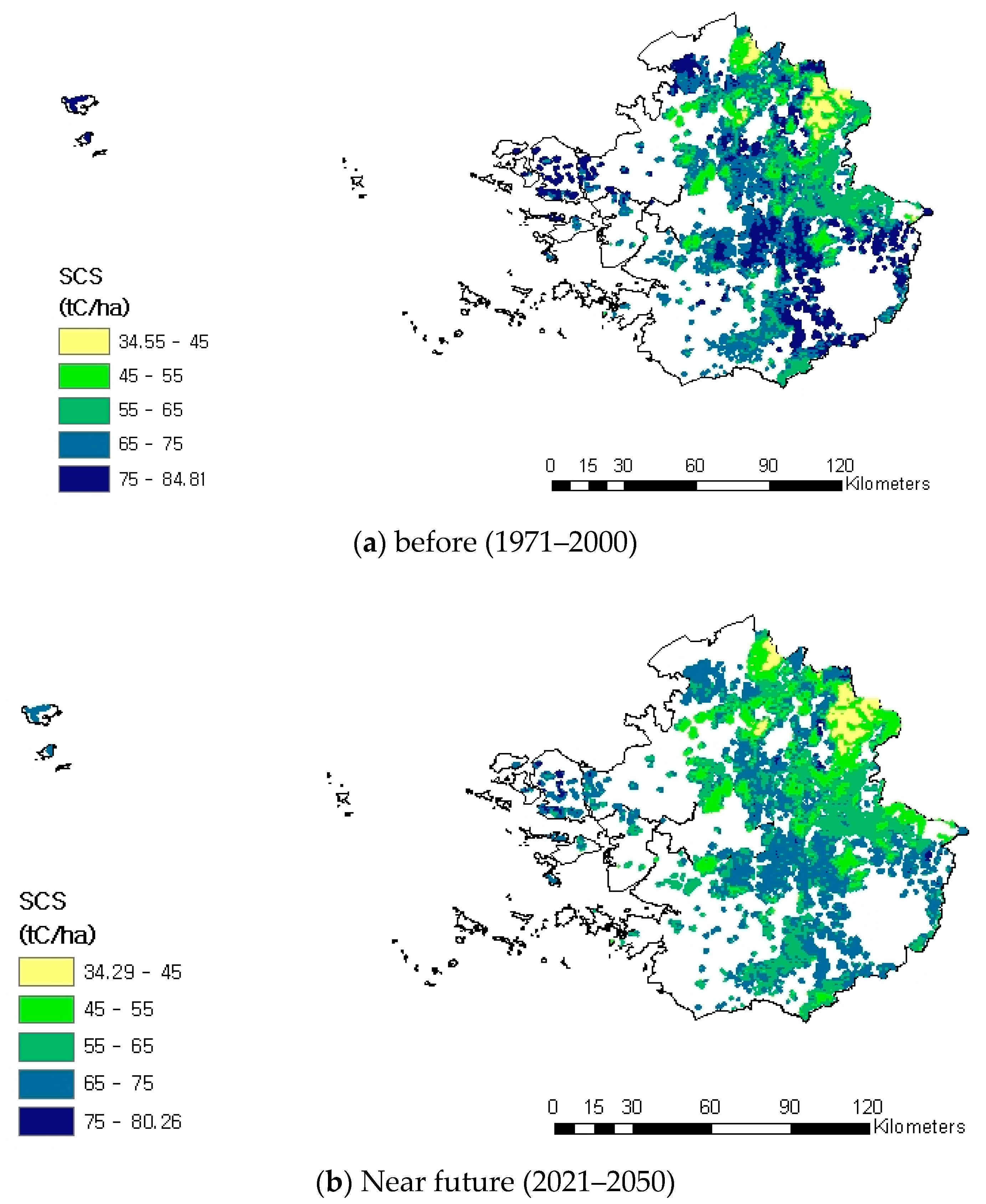
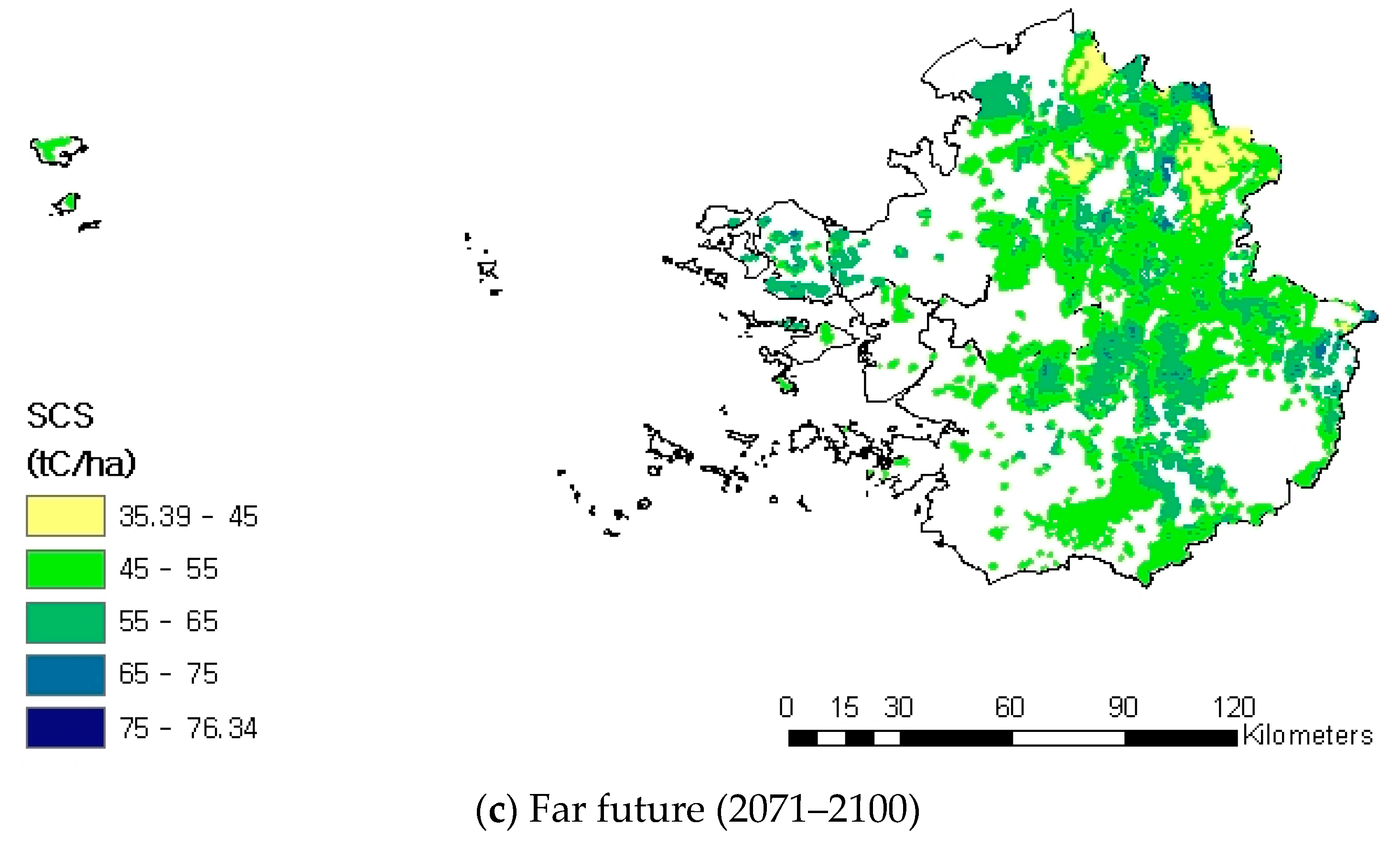

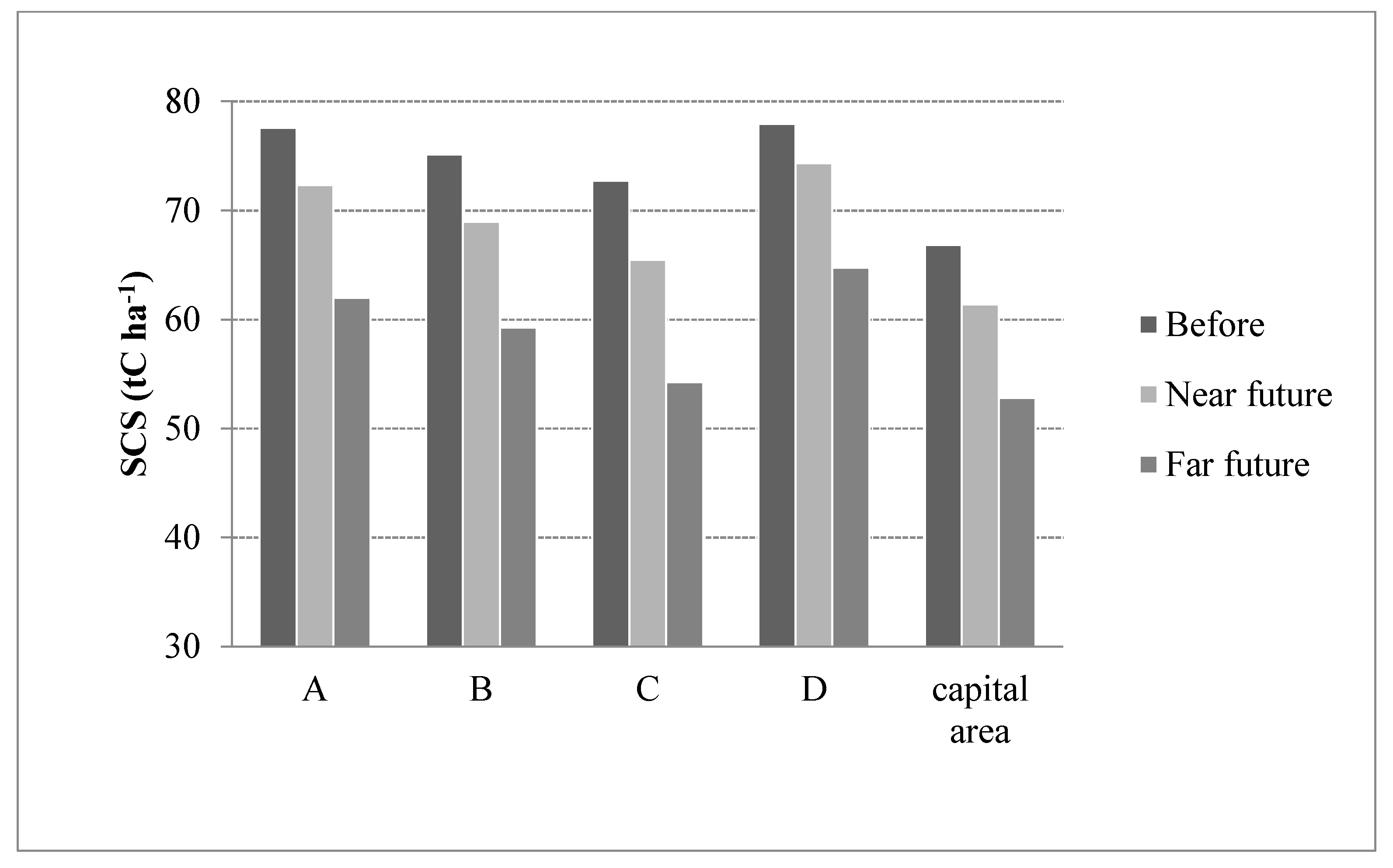
| Before (2000) | Near Future (2050) | Far Future (2100) | ||
|---|---|---|---|---|
| Without Human interference * | NPP (TgC year−1) | 3401 | 3305 | 3322 |
| SCS (TgC) | 37,766 | 34,676 | 29,839 | |
| Considering Human Interference ** | NPP (TgC year−1) | 3401 | 2836 | 2276 |
| SCS (TgC) | 37,766 | 29,753 | 20,437 | |
| Decline of NPP | Contribution of Climate Change (%) | Contribution of Human Activity (%) |
| Near future (2050) | 17 | 83 |
| Far future (2100) | 7 | 93 |
| Decline of SCS | Contribution of Climate Change (%) | Contribution of Human Activity (%) |
| Near future (2050) | 39 | 61 |
| Far future (2100) | 46 | 54 |
© 2018 by the authors. Licensee MDPI, Basel, Switzerland. This article is an open access article distributed under the terms and conditions of the Creative Commons Attribution (CC BY) license (http://creativecommons.org/licenses/by/4.0/).
Share and Cite
Lee, S.-D.; Kwon, S.-S. Carbon Sequestration in the Urban Areas of Seoul with Climate Change: Implication for Open Innovation in Environmental Industry. J. Open Innov. Technol. Mark. Complex. 2018, 4, 48. https://doi.org/10.3390/joitmc4040048
Lee S-D, Kwon S-S. Carbon Sequestration in the Urban Areas of Seoul with Climate Change: Implication for Open Innovation in Environmental Industry. Journal of Open Innovation: Technology, Market, and Complexity. 2018; 4(4):48. https://doi.org/10.3390/joitmc4040048
Chicago/Turabian StyleLee, Sang-Don, and Sun-Soon Kwon. 2018. "Carbon Sequestration in the Urban Areas of Seoul with Climate Change: Implication for Open Innovation in Environmental Industry" Journal of Open Innovation: Technology, Market, and Complexity 4, no. 4: 48. https://doi.org/10.3390/joitmc4040048






